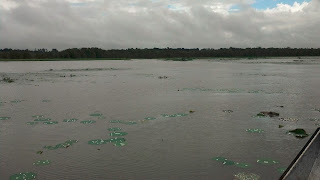In a recent news release, the successful application of the salvinia weevil to control giant salvinia on Lake Steinhagen was showcased (http://today.agrilife.org/2012/09/20/weevils-successfully-destroy-acres-of-lake-invading-plants/). In a coordinated effort, the US Army Corps of Engineers (USACE) has been working with the Texas Parks and Wildlife Department (TPWD) Aquatic Habitat Enhancement Program staff from Jasper to use the salvinia weevil to combat giant salvinia on the lake. In late 2010, TPWD began releasing weevils on one area of the lake and through March of 2012 had released about 112,000 weevils. During this time, USACE did not apply chemicals to this area in an effort to see what the weevils were capable of. The pictures clearly describe their capabilities under good conditions.
Giant salvinia coverage on upper end of Lake Steinhagen, April 2012
In April 2012, giant salvinia was estimated to cover about 300 in this area of Lake Steinhagen. By August, the coverage area was conservatively estimated at only 150 acres and had led to open water in the middle of that area. What giant salvinia remains is isolated to the edge of the lake and mats of other vegetation. While the weevils haven't removed all the giant salvinia, they do show the ability to manage giant salvinia when it is present.
Same area of Lake Steinhagen, August 2012
In an effort to get some more research bang for the buck, Dr. Abhishek Mukherjee of the Center for Invasive Species Eradication team worked with TPWD and USACE personnel to study the weevil population dynamics and document their impacts. Some of their findings describe why and how this successful reduction in giant salvinia came about this year.
In February and March 2012, documented weevil densities were in the 20 to 30 weevils per kilogram of giant salvinia range indicating that a sizable population of weevils had survived the winter on Lake Steinhagen. These relatively high numbers of weevils coming out of the winter enabled the population to expand rapidly. By late July, weevil numbers had more than doubled to just over 60 weevils per kilogram of giant salvinia. This number of weevils is widely considered the weevil density needed to suppress giant salvinia growth.
Ultimately, we hope to see similar success with biocontrol at Caddo Lake. The challenge is maintaining adequate weevil populations on the Lake through the winter. With Caddo Lake being more that 100 miles farther north than Lake Steinhagen, this may be difficult. Efforts at Caddo continue to explore ways to enhance the cold tolerance of the salvinia weevils and some live weevils were found late this past winter on Caddo, but their numbers were much lower than those on Lake Steinhagen.
So for now, we will continue releasing weevils on Caddo and hope for another mild winter that will allow their populations to persist and flourish early next spring.



No comments:
Post a Comment